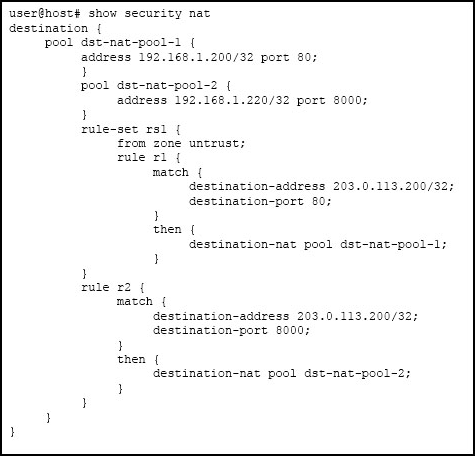Juniper JN0-333 Security, Specialist (JNCIS-SEC) Online Training
Juniper JN0-333 Online Training
The questions for JN0-333 were last updated at Apr 21,2025.
- Exam Code: JN0-333
- Exam Name: Security, Specialist (JNCIS-SEC)
- Certification Provider: Juniper
- Latest update: Apr 21,2025
What are two supported hypervisors for hosting a vSRX? (Choose two.)
- A . VMware ESXi
- B . Solaris Zones
- C . KVM
- D . Docker
You are asked to change when your SRX high availability failover occurs. One network interface is considered more important than others in the high availability configuration. You want to prioritize failover based on the state of that interface.
Which configuration would accomplish this task?
- A . Create a VRRP group configuration that lists the reth’s IP address as the VIP while using each physical interface that make up the reth definition of each SRX HA pair.
- B . Configure IP monitoring of the important interface’s IP address and adjust the heartbeat interval and heartbeat threshold to the shortest settings.
- C . Create a separate redundancy group to isolate the important interface; set the priority of the new redundancy group to 255.
- D . Configure interface monitor inside the redundancy group that contains the important physical interface; adjust the weight associated with the monitored interface to 255.
Which three Encapsulating Security Payload protocols do the SRX Series devices support with IPsec? (Choose three.)
- A . DES
- B . RC6
- C . TLS
- D . AES
- E . 3DES
What are three characteristics of session-based forwarding, compared to packet-based forwarding, on an SRX Series device? (Choose three.)
- A . Session-based forwarding uses stateful packet processing.
- B . Session-based forwarding requires less memory.
- C . Session-based forwarding performs faster processing of existing session.
- D . Session-based forwarding uses stateless packet processing,
- E . Session-based forwarding uses six tuples of information.
You have configured source NAT with port address translation. You also need to guarantee that the same IP address is assigned from the source NAT pool to a specific host for multiple concurrent sessions.
Which NAT parameter would meet this requirement?
- A . port block-allocation
- B . port range twin-port
- C . address-persistent
- D . address-pooling paired
You have configured source NAT with port address translation. You also need to guarantee that the same IP address is assigned from the source NAT pool to a specific host for multiple concurrent sessions.
Which NAT parameter would meet this requirement?
- A . port block-allocation
- B . port range twin-port
- C . address-persistent
- D . address-pooling paired
168.150.111 using HTTP?
- A . The client will be denied by policy p2.
- B . The client will be denied by policy p1.
- C . The client will be permitted by policy p2.
- D . The client will be permitted by policy p1.
Click the Exhibit button.

Which feature is enabled with destination NAT as shown in the exhibit?
- A . NAT overload
- B . block allocation
- C . port translation
- D . NAT hairpinning
Which two statements about security policy actions are true? (Choose two.)
- A . The log action implies an accept action.
- B . The log action requires an additional terminating action.
- C . The count action implies an accept action.
- D . The count action requires an additional terminating action.
Which two statements are true about global security policies? (Choose two.)
- A . Global security policies are evaluated before regular security policies.
- B . Global security policies can be configured to match addresses across multiple zones.
- C . Global security policies can match traffic regardless of security zones.
- D . Global security policies do not support IPv6 traffic.
Latest JN0-333 Dumps Valid Version with 75 Q&As
Latest And Valid Q&A | Instant Download | Once Fail, Full Refund

